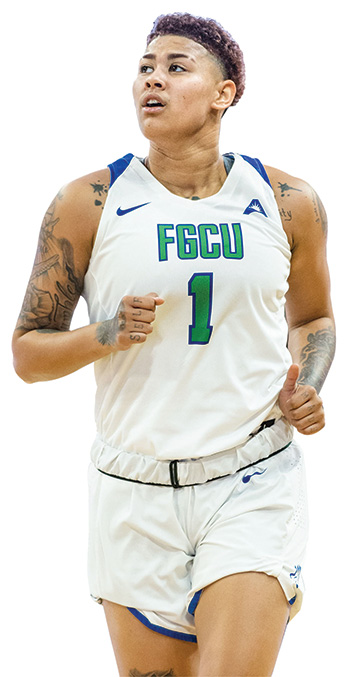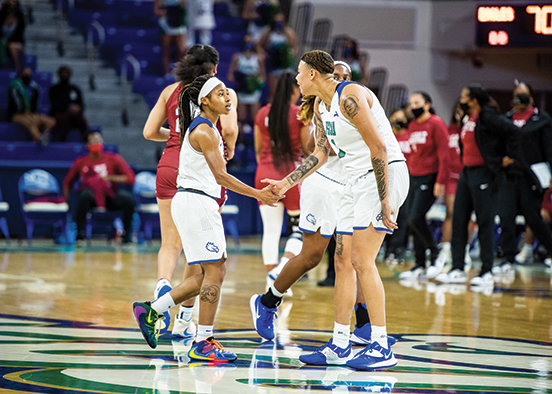
played a key role in the team’s success.
FGCU women’s basketball players Kierstan Bell and Tishara “TK” Morehouse looked at each other and laughed in unison, their friendship off the court as evident as their cohesion on it.
“You can talk,” the diminutive Morehouse said shyly to the taller, more vocal Bell when asked about their uncanny success in their first season with the Eagles.
“I just talked,” Bell replied, triggering more laughter from the duo.
Just minutes earlier, even as the Eagles danced and celebrated yet another ASUN tournament title and berth in the NCAA Tournament, their cerebral, now storied coach was doing what would have been the oddest of things prior to this season.
He was trying to keep his players apart. “You hate to tell players not to be celebrating on the court. But I was out there trying to get everybody to space out,” said Eagles coach Karl Smesko, named the ASUN Coach of the Year for the 11th time in FGCU’s 14 seasons in the league. “We want to be able to celebrate again.”
In a world turned sideways by the COVID-19 pandemic, FGCU distinguished itself among the nation’s elite programs yet again in 2020-21 not just for its on-court exploits. Even with a first-round loss in the NCAA Tournament to a Michigan team widely thought to be under-seeded, the Eagles warranted praise, firstly, for simply playing all their scheduled games, something many peers in the 64-team NCAA Tournament did not do.
“I was somebody who was pretty skeptical of how many games we’d actually get to play this year with the COVID situation,” said Smesko, who saw his team’s favorite status going into the ASUN Tournament final at the end of the 2019-20 season wiped out by COVID-19, leaving this year’s NCAA Tournament appearance as the program’s seventh in 10 eligible seasons.
“Our players made a lot of sacrifices to make it possible for us to have essentially a full season,” said Smesko, noting multiple weekly tests and extra social distancing-restrictions. “You just had to be ultra-responsible if you wanted to have your season, and our players did a really good job with it making those types of sacrifices for the betterment of the team.”
The restrictions made FGCU’s on-court success all the more remarkable – and arguably unthinkable if not for the kind of team-wide unity Bell and Morehouse helped showcase.
After losing all five starters and the top seven scorers from last year’s 30-3 team, FGCU didn’t even know who would play this season because of multiple transfers and waiver requests for immediate eligibility, including for the highly touted Bell.
When the 6-foot-1 Bell, the three-time Ohio high school Ms. Basketball award-winner before playing one season at The Ohio State University, was declared eligible three games into the season, FGCU’s prospects improved greatly.
Still, given the many intricacies of Smesko’s systems, his past teams that have endured major roster turnover routinely have struggled out of the gate.
“It happened really quickly how good we started playing together,” Bell, the first in ASUN history to be named Player and Newcomer of the Year, told the Canton Repository.
“We just enjoy being around each other, competing at practice and learning new information. Because a lot of us were new, either transferring over or incoming freshmen, everybody had a learning mindset. I think that’s what brought us up another level.”
Bell, an Associated Press honorable mention All-America and winner of the prestigious Becky Hammon Mid-Major Player of the Year award, was instrumental helping FGCU to a 25-game winning streak, 26-3 overall record and rankings in both major polls.

That included the No. 24 ranking in the AP poll, FGCU’s first since finishing the 2014-15 season at No. 20. FGCU was No. 21 in the coaches’ poll entering this year’s tournament.
But also critical were fellow newcomers Morehouse, Aaliyah Stanley and Andrea Cecil, as well as returning players Alyssa Blair, Tyra Cox and Emma List, among other contributors.
“We were very fortunate. Our assistant coaches did a great job helping bring in some really talented players, and helping develop some returning players,” Smesko said. “(Blair, Cox and List) really took such a step forward this year. For a team with so many new players to be able to have the kind of season they were able to experience was pretty remarkable.”
In the NCAA Tournament, FGCU’s hopes to advance to the Sweet 16 for the first time in program history were doused early by an exemplary performance from Michigan. The sixth-seeded Wolverines, ranked 16th in the AP media poll and 14th in the USA Today coaches poll at the time, raced away from 11th-seeded FGCU in the fourth quarter of the 87-66 decision. It was the first time in seven NCAA appearances FGCU didn’t win or go down to the wire or overtime in the first round.
Michigan backed up arguments it had been worthy of a better seed by rolling through third-seeded Tennessee 70-55 in the second round.
But even with the disheartening loss, FGCU was able to appreciate all it accomplished this year bolstering its reputation as one of the nation’s top programs.
“Coming from (junior college) and being able to transfer here and get to the NCAA Tournament my first year is an amazing experience,” said the 5-foot-3 Morehouse, who was a unanimous First Team All-ASUN selection. “I can’t wait to come back next year.”
With only Blair and fellow senior Sheahen Dowling scheduled to depart, that seems more likely than it did entering this most unusual of seasons.
“We should have a lot of exceptionally talented players returning,” said Smesko, also noting FGCU’s potential to land a couple of “high-caliber” Division-I transfers in the offseason.
“I’m really excited, because usually (between) players’ first and second year in our program is when they make the biggest jump. If we can do that, I think we can take another big step forward.”